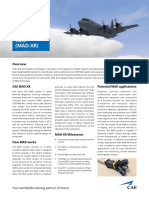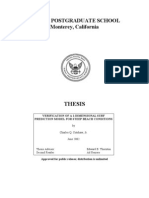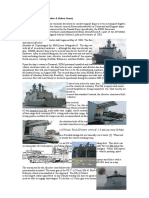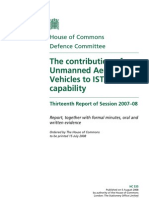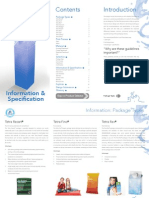0 ratings0% found this document useful (0 votes)
196 viewsBody Mm07776 Seaspray 7000E LQ
Body Mm07776 Seaspray 7000E LQ
Uploaded by
ultrapampersSeaspray 7000E is a member of the successful Seaspray family of surveillance radars. It combines a state-of-the-art AESA with a commercial-off-the-shelf (COTS) processor to deliver a leading edge capability. The radar is now fully integrated into the AW159 Lynx wildcat.
Copyright:
© All Rights Reserved
Available Formats
Download as PDF, TXT or read online from Scribd
Body Mm07776 Seaspray 7000E LQ
Body Mm07776 Seaspray 7000E LQ
Uploaded by
ultrapampers0 ratings0% found this document useful (0 votes)
196 views2 pagesSeaspray 7000E is a member of the successful Seaspray family of surveillance radars. It combines a state-of-the-art AESA with a commercial-off-the-shelf (COTS) processor to deliver a leading edge capability. The radar is now fully integrated into the AW159 Lynx wildcat.
Copyright
© © All Rights Reserved
Available Formats
PDF, TXT or read online from Scribd
Share this document
Did you find this document useful?
Is this content inappropriate?
Seaspray 7000E is a member of the successful Seaspray family of surveillance radars. It combines a state-of-the-art AESA with a commercial-off-the-shelf (COTS) processor to deliver a leading edge capability. The radar is now fully integrated into the AW159 Lynx wildcat.
Copyright:
© All Rights Reserved
Available Formats
Download as PDF, TXT or read online from Scribd
Download as pdf or txt
0 ratings0% found this document useful (0 votes)
196 views2 pagesBody Mm07776 Seaspray 7000E LQ
Body Mm07776 Seaspray 7000E LQ
Uploaded by
ultrapampersSeaspray 7000E is a member of the successful Seaspray family of surveillance radars. It combines a state-of-the-art AESA with a commercial-off-the-shelf (COTS) processor to deliver a leading edge capability. The radar is now fully integrated into the AW159 Lynx wildcat.
Copyright:
© All Rights Reserved
Available Formats
Download as PDF, TXT or read online from Scribd
Download as pdf or txt
You are on page 1of 2
The Seaspray 7000E Active Electronically Scanned Array
(AESA) multi-mode surveillance radar provides an unrivalled
surveillance capability as the primary sensor on airborne
assets to meet the challenges of the 21st century.
The Seaspray range of radars has been delivering high
performance surveillance capabilities to armed forces and
paramilitary users for over 40 years. Seaspray 7000E is a
member of the successful Seaspray family of surveillance
radars, which also comprises the Seaspray 5000E and
Seaspray 7500E. It combines a state-of-the-art AESA with
a Commercial-Off-The-Shelf (COTS) processor to deliver a
leading edge capability covering air-to-surface, air-to-air and
air-to-ground environments. Selex ES are proud that the
UK Royal Navy selected the Seaspray 7000E as the launch
Customer, and it is now fully integrated into the state-of-the-
art AW159 Lynx Wildcat.
KEY FEATURES
AESA technology and fexible waveform generation capability
enables Seaspray 7000E to deliver peak performance in all
modes.
Use of multiple low power, solid state Transmit/Receive
Modules (TRM) makes the Seaspray 7000E radar more
reliable than conventional radar systems. This results in a
signifcant cost beneft over the life of the system. Superior
performance in detecting small targets, such as Fast
Inshore Attack Craft (FIAC) in high sea states, through use of
composite mechanical and electronic scanning.
Interleaved modes by virtue of its ability to change
waveforms pulse-to-pulse. For instance, surface surveillance
and weather detection can be provided simultaneously.
Effectively two radars within one system. Comprising just
two primary air cooled Line Replaceable Units (LRU) and
requiring no waveguide, Seaspray 7000E is easy to install.
Seaspray 7000E can be provided as a turnkey solution with
embedded navigation sensors and Human Machine Interface
(HMI) or as a sensor solution to integrate with a platform
mission system using industry standard interfaces.
KEY BENEFITS
Excellent performance
Low cost of ownership
True multi-mode operation
Superior reliability, enabling mission success
Ease of installation
Easy to use
Mode interleaving
Flexible system integration options.
SEASPRAY 7000E
MULTI-MODE SURVEILLANCE RADAR
Radar & Advanced Targeting
TECHNICAL SPECIFICATION
Characteristics
Frequency X Band
Scan Coverage 360
Maximum Range 200NM (320NM Weather Mode)
Mean Time Between Failure (MTBF) 2,000 hours
Cooling Unconditioned air
Weight 86.2kg (Antenna and Processor
LRUs)
Dimensions (approx.)
Processor 260x500x210mm
Scanner 540x886x281mm
Swept volume
IFF Interrogator Antenna 285x880x40mm (large)
165x800x40mm (small)
Interfaces
Standard Ethernet, RS422, RS232
Other available on request
Video Outputs Multiple options for Mission System
and cockpit display compatibility
Functions
Track While Scan Automatic up to 200 tracks
Track Identifcation AIS integration, ISAR and IFFi
(optional)
Mode Interleaving Simultaneous dual-mode operation
EO Integration Option
Capabilities
Surface surveillance Long Range Search
Priority Track
Small Target Mode
Navigation Land Mass Discrimination
Weather Detection
Turbulence Detection
Beacon Detection Search and Rescue
Transponder (SART)
Target Imaging/ Classifcation ISAR
Range Profling
Ground Mapping
Spot SAR High resolution ground
mapping
Strip SAR Medium resolution wide
Area ground mapping
Oil slick detection
Iceberg detection
Moving Target Detection GMTI
Air-to-air MTI
Air-to-Air Dedicated Air-to-Air mode
ADS-B (option)
IFFi (option)
PERFORMANCE BENEFIT OF AESA RADAR
The composite mechanical and electronic scanning
enables conventional scan rate wide area search while
simultaneously fast scanning every target to give vastly
improved clutter cancellation and superior detection
performance. This performance is maintained from high
altitudes typically encountered by UAVs operating at the full
extent of their LOS data links.
SUPERIOR OPERATIONAL AVAILABILITY & RELIABILITY
The Seaspray 7000E AESA minimises the impact of
transmitter failure by removing this single point failure, high
power, relatively low MTBF LRU. This is replaced by many
Transmit Receive Modules (TRMs) with high MTBFs within the
antenna array. At the core of the AESA radar design is the
ability to tolerate individual item failure. Component failures
within the array result in graceful performance degradation
rather than complete system failure, delivering high
operational availability when compared with conventional
radar systems.
Due to its high reliability and availability the customer has
a reduced maintenance requirement and has the option to
reduce spares holding, resulting in signifcant cost benefts
over the life of the system.
BACKGROUND
As a company we have been at the forefront of the airborne
radar market since the 1950s when the AI23 radar
became the worlds frst high power monopulse radar to
enter squadron service. Maintaining our leading position
in the market, we have been developing AESA technology
since the early 1990s and now possess a range of AESA
radar products capable of meeting the requirements of the
airborne radar market.
Within our radar Centre of Excellence, we have designed,
developed and supported radar systems for over 60
years. Our Software Development capability meets the
requirements of CMM Level 5. Over 3000 radar systems
have been supplied for fxed and rotary wing aircraft in
surveillance, fre control and ground attack roles. We
have extensive experience of surveillance radar and have
produced more than 700 systems in our Seaspray, PicoSAR
and Blue Kestrel families of radars.
Inverse Synthetic Aperture Radar
(ISAR) Imagery
Oil rig
2014 Copyright Selex ES Ltd www.selex-es.com ASD MM07776 2-14
For more information please email infomarketing@selex-es.com
Selex ES Ltd - A Finmeccanica Company
2 Crewe Road North, Edinburgh, EH5 2XS, United Kingdom, Tel: +44 (0) 131 343 8016, Fax: +44 (0) 131 343 8616
This publication is issued to provide outline information only and is supplied without liability for errors or omissions. No part of it may be reproduced or used unless authorised in writing.
We reserve the right to modify or revise all or part of this document without notice.
You might also like
- 108 Fórmulas MagicasDocument195 pages108 Fórmulas MagicasHernan Loboa100% (8)
- NILEPMODocument52 pagesNILEPMOdky fei100% (1)
- Thales CATSDocument2 pagesThales CATSPark SungNo ratings yet
- Arena 65 LCMDocument2 pagesArena 65 LCMRNo ratings yet
- Euroflir 350Document2 pagesEuroflir 350Marco Polo0% (1)
- Agat New Generation of Active Radar Homing HeadsDocument2 pagesAgat New Generation of Active Radar Homing HeadsWingexheroNo ratings yet
- Damen Schelde Naval Shipbuilding: Joint Support Ship "Karel Doorman"Document2 pagesDamen Schelde Naval Shipbuilding: Joint Support Ship "Karel Doorman"DaniëlSwetsNo ratings yet
- Sea Giraffe AMB Web LowDocument6 pagesSea Giraffe AMB Web LowVictor PileggiNo ratings yet
- MF StarDocument2 pagesMF StarDrSomnath999No ratings yet
- Thales - Datasheet APAR DS117!10!10 H HRDocument2 pagesThales - Datasheet APAR DS117!10!10 H HRMartin Schweighart MoyaNo ratings yet
- Seaspray 7500E LQDocument2 pagesSeaspray 7500E LQtomay777100% (1)
- Branko Petricevic - Activity of The Hydrographic Institute of The Republic of Croatia and Integrated Hydrographic SystemsDocument23 pagesBranko Petricevic - Activity of The Hydrographic Institute of The Republic of Croatia and Integrated Hydrographic Systemslapost_fer100% (1)
- V2 N4 1981 Flanagan Advanced PDFDocument3 pagesV2 N4 1981 Flanagan Advanced PDFraa2010100% (1)
- Inmarsat Govt Aero - Americas CompressedDocument46 pagesInmarsat Govt Aero - Americas CompressedJhonathan Julian Afanador Gonzalez100% (1)
- AFM - Vol 2 - Generic Enemy (Basic Forces) - Part 3 - OrBATsDocument148 pagesAFM - Vol 2 - Generic Enemy (Basic Forces) - Part 3 - OrBATsPG100% (1)
- PEO Ships Brief To NDIA PDFDocument43 pagesPEO Ships Brief To NDIA PDFjwpaprk1100% (1)
- Transformation of The SA NavyDocument72 pagesTransformation of The SA NavyChris B.No ratings yet
- CAE MAD-XR DatasheetDocument2 pagesCAE MAD-XR Datasheetrengab100% (1)
- Netherlands MCMDocument3 pagesNetherlands MCMaxiswarlordhcvNo ratings yet
- Naval Postgraduate School Monterey, California: ThesisDocument41 pagesNaval Postgraduate School Monterey, California: ThesisNini Brevis100% (1)
- Handbook - For EncodingDocument179 pagesHandbook - For Encodingcha1234567890No ratings yet
- Effects of Chaff Screening and RCSDocument14 pagesEffects of Chaff Screening and RCSRoberto Pita100% (1)
- D1485e Vampir NGDocument2 pagesD1485e Vampir NGzarrarNo ratings yet
- Austal LCS 127 Data SheetDocument2 pagesAustal LCS 127 Data SheetNugNo ratings yet
- C Users Uday AppData Local Opera Opera Profile Cache4 Opr0056b PDFDocument5 pagesC Users Uday AppData Local Opera Opera Profile Cache4 Opr0056b PDFUdayanand KarriNo ratings yet
- Saab Sea Giraffe Naval RadarsDocument2 pagesSaab Sea Giraffe Naval RadarsShiva SinghNo ratings yet
- VOGO SDV 1000w - EngDocument1 pageVOGO SDV 1000w - Engmootaz_ahmed464No ratings yet
- Passive Sonar LOPAS: Specifi Cations and Technical DataDocument4 pagesPassive Sonar LOPAS: Specifi Cations and Technical DataMrityunjoy MazumdarNo ratings yet
- DBL SeaHake 01Document2 pagesDBL SeaHake 01srichalam01No ratings yet
- BMT Caimen 90 Fast DatasheetDocument2 pagesBMT Caimen 90 Fast DatasheetVictor Pileggi100% (1)
- TSS Meridian Gyrocompasses Product LeafletDocument4 pagesTSS Meridian Gyrocompasses Product Leafletlucas barriosNo ratings yet
- Gaav Uav FalcoDocument2 pagesGaav Uav Falcotomay777No ratings yet
- Nulka: Anti-Ship Missile Self Defense SystemDocument4 pagesNulka: Anti-Ship Missile Self Defense SystemlalalNo ratings yet
- I-MAST 400: Superb All-Around PerformanceDocument2 pagesI-MAST 400: Superb All-Around PerformanceShiva SinghNo ratings yet
- Materielkommando) and The Odense Lindø Shipyard (Odense Staalskibsværft, A Part of The AP MøllerDocument3 pagesMaterielkommando) and The Odense Lindø Shipyard (Odense Staalskibsværft, A Part of The AP MøllerAlex Borboudakis100% (1)
- Modularity in MCMDocument27 pagesModularity in MCMThinkDefenceNo ratings yet
- Fast Attack Combatant For Near-Shore OperationDocument11 pagesFast Attack Combatant For Near-Shore OperationVokramNo ratings yet
- Istar and UavDocument149 pagesIstar and UavAlexa Alexandra100% (1)
- El 8212 Jamming PodDocument2 pagesEl 8212 Jamming PodDrSomnath999No ratings yet
- Gabbiano Ultralight RadarDocument2 pagesGabbiano Ultralight RadarVictor PileggiNo ratings yet
- Eye in The Skies: AwheroDocument4 pagesEye in The Skies: AwheroVictor Pileggi100% (1)
- Captas-2 - Customer OnlineDocument2 pagesCaptas-2 - Customer Onlinenaoki asamiNo ratings yet
- Sunburns, Yakhonts, Alfas and The Region (Australian Aviation, Sept 2000.)Document14 pagesSunburns, Yakhonts, Alfas and The Region (Australian Aviation, Sept 2000.)Cue Pue100% (1)
- ACV 03 Aug 08Document2 pagesACV 03 Aug 08Alan MckenNo ratings yet
- Brochure4 XRGL40-2Document2 pagesBrochure4 XRGL40-2Aaron Hellrung100% (1)
- Body Mm07797 Pirate IRST LQ March14Document2 pagesBody Mm07797 Pirate IRST LQ March14ultrapampersNo ratings yet
- Milas EngDocument2 pagesMilas EngMarouan Ben SaadaNo ratings yet
- B036e0222 Oerlikon Millennium Gun SystemDocument8 pagesB036e0222 Oerlikon Millennium Gun Systemyangzhengjiu99100% (1)
- KRONOS Grand Naval LQ mm07943 PDFDocument2 pagesKRONOS Grand Naval LQ mm07943 PDFsamsulkhoirulanamNo ratings yet
- HSM DatasheetDocument2 pagesHSM DatasheetMrityunjoy MazumdarNo ratings yet
- Captas Flyer 3 13 UpdateDocument2 pagesCaptas Flyer 3 13 UpdateDhamodaran RNo ratings yet
- Long Range AESA Air & Surface Surveillance RadarDocument2 pagesLong Range AESA Air & Surface Surveillance RadarShiva Singh100% (1)
- TF April 2014 WebDocument20 pagesTF April 2014 WebNick SNo ratings yet
- Datasheet Lirod Mk2 Ds169!10!12 HRDocument2 pagesDatasheet Lirod Mk2 Ds169!10!12 HR////No ratings yet
- Swath Bathymetry & Side Scan Sonar: Features & BenefitsDocument2 pagesSwath Bathymetry & Side Scan Sonar: Features & BenefitsRich ManNo ratings yet
- Baes 060856Document2 pagesBaes 060856ThinkDefenceNo ratings yet
- Naval Innovation for the 21st Century: The Office of Naval Research Since the End of the Cold WarFrom EverandNaval Innovation for the 21st Century: The Office of Naval Research Since the End of the Cold WarNo ratings yet
- China, the United States, and 21st-Century Sea Power: Defining a Maritime Security PartnershipFrom EverandChina, the United States, and 21st-Century Sea Power: Defining a Maritime Security PartnershipNo ratings yet
- Seaspray 7500E Multi-Mode Surveillance Radar: Key Features Key BenefitsDocument2 pagesSeaspray 7500E Multi-Mode Surveillance Radar: Key Features Key BenefitsKristi BradyNo ratings yet
- Vixen 1000E - Electronically Scanned AESA Radar (mm08133) HQDocument2 pagesVixen 1000E - Electronically Scanned AESA Radar (mm08133) HQJosé Luis DelgadoNo ratings yet
- Body Mm08014 BriteCloud LQDocument4 pagesBody Mm08014 BriteCloud LQultrapampersNo ratings yet
- Body Mm07797 Pirate IRST LQ March14Document2 pagesBody Mm07797 Pirate IRST LQ March14ultrapampersNo ratings yet
- Body mm07761 Mirach 100 5 LQDocument2 pagesBody mm07761 Mirach 100 5 LQultrapampersNo ratings yet
- FLASH-S Dipping SonarDocument2 pagesFLASH-S Dipping SonarultrapampersNo ratings yet
- 855-164415 Ad Ss2030 Product SpecificationDocument2 pages855-164415 Ad Ss2030 Product SpecificationultrapampersNo ratings yet
- GatorDocument2 pagesGatorultrapampersNo ratings yet
- JAI-763 Online - 231013 - 111357Document14 pagesJAI-763 Online - 231013 - 111357praveen.malikupNo ratings yet
- Free OCR To Word Guide: Follow The Easy Steps BelowDocument11 pagesFree OCR To Word Guide: Follow The Easy Steps BelowDindin NuryadinNo ratings yet
- Company Offer Letter Format PDFDocument2 pagesCompany Offer Letter Format PDFadnanshaikh09No ratings yet
- CT Remote Control Kit User Instruction - UM - 5849873-199 - EN - 1Document16 pagesCT Remote Control Kit User Instruction - UM - 5849873-199 - EN - 1Luis Fernando Garcia SNo ratings yet
- Technical Handy Guide: MX-M264N MX-M314N MX-M354N CapricornDocument32 pagesTechnical Handy Guide: MX-M264N MX-M314N MX-M354N CapricornDoicho AndonovNo ratings yet
- Assignment:-1: Introduction To Computer Graphics QuestionsDocument16 pagesAssignment:-1: Introduction To Computer Graphics QuestionsDrashti PatelNo ratings yet
- Bizhub287 227ServiceLaunchGuideDocument75 pagesBizhub287 227ServiceLaunchGuideMarck JunoNo ratings yet
- 95uvs4 1cexDocument59 pages95uvs4 1cexMudasir ATNo ratings yet
- Design ManualDocument14 pagesDesign ManualHoracio Bernadou100% (1)
- 7872 Owner GuideDocument46 pages7872 Owner Guidefelu77No ratings yet
- Photo Modeler ComparisonDocument6 pagesPhoto Modeler ComparisonWolf Crew AzraiNo ratings yet
- KTM PresentationDocument13 pagesKTM Presentationmk59030No ratings yet
- Arsenal Abis: Automated Ballistics Identification SystemDocument2 pagesArsenal Abis: Automated Ballistics Identification SystemMeho MehićNo ratings yet
- Quick SetupDocument57 pagesQuick SetupTheo HennemanNo ratings yet
- Student Documentation Datacard System: Software RequirementsDocument2 pagesStudent Documentation Datacard System: Software RequirementsJAWAHAR BALARAMAN0% (1)
- Devicenet PDFDocument33 pagesDevicenet PDF13qtparece100% (1)
- Rugged, High-Performance Single-Channel GPR Data Acquisition SystemDocument2 pagesRugged, High-Performance Single-Channel GPR Data Acquisition SystemKaharuddin HawingNo ratings yet
- MCShield Help enDocument16 pagesMCShield Help enNestor David Lagos GarcíaNo ratings yet
- BIOMETRICS - A Seminar ReportDocument62 pagesBIOMETRICS - A Seminar ReportHemant MahajanNo ratings yet
- Computer Fundamental QBDocument4 pagesComputer Fundamental QBTanuja SinghNo ratings yet
- MemorDocument4 pagesMemorChristopher ToddNo ratings yet
- Del Rosario V CWDocument10 pagesDel Rosario V CWCj GarciaNo ratings yet
- MSI Product CatalogDocument89 pagesMSI Product CatalogAnil AbrahamNo ratings yet
- Product Brochure HP X58045Document17 pagesProduct Brochure HP X58045terNo ratings yet
- Ik Cu51 Ik m51h Ik Um51h LeafletDocument4 pagesIk Cu51 Ik m51h Ik Um51h LeafletFirdaus MufipezooNo ratings yet
- Fi 7260 DatasheetDocument2 pagesFi 7260 DatasheetDodi VenesiaNo ratings yet
- VersaDoc MP 4000 Sole Source SpecificationsDocument3 pagesVersaDoc MP 4000 Sole Source SpecificationsdnajenNo ratings yet
- RAM and ROM Haardware SoftwareDocument3 pagesRAM and ROM Haardware SoftwareFilza FatimaNo ratings yet
- Bizhub c287 c227 Quick Reference en 1 0 0Document4 pagesBizhub c287 c227 Quick Reference en 1 0 0Badr BiuoNo ratings yet

















